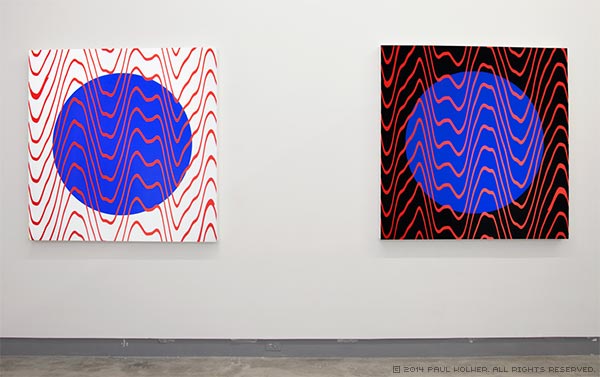
Paul Kolker: Flatland Reimagined…A Romance of the Line and the Dot (installation view)
Inspired by Edwin A. Abbott’s 1884 novel, Flatland: A Romance of Many Dimensions, Kolker self-curates and creates the art for this exhibition under the umbra of the artist’s wholly reductionistic thesis statement which reimagines, using both abstraction and minimalism, a hypothetical twenty-first century world in which, according to Kolker, “a dot may be a universe and a universe a dot.” Scientific reductionism, Kolker explains, uses microscopic, molecular and subatomic components to define the physical laws of macroscopic phenomena such as thermodynamics, for example. Thus, the minimalist and abstract paintings in this show are dispositive as reductions of that macroscopic narrative, A Romance of the Line and the Dot. A line is an iteration of dots; or as Abbott wrote more than a century ago, “if a Point moves Northward, and leaves a luminous wake, what name would you give to the wake?…A straight line.”
Kolker also cites to publications in the neuro- and behavioral-science literature regarding the physiology of perception, demonstrating uptake areas of high metabolic activity through special glucose-nucleotide tracer scans which indicate that the visual, auditory and position-related (proprioceptive and vestibular) sensory apparatuses link with both the cognitive and empathic cerebral regions; as well as also linking with memory archival regions and with the neurohumoral and autonomic centers in the brain-stem. Furthermore, the works in this show, as well as the exhibition itself as a curated work of art, may evoke feelings which trigger the viewer’s insights, imagination and intuition; generate vibrations, otherwise called vibes; promote cognition, or even recognition based on prior experiences, learned biases or prejudices. Or, perhaps, in spite of the impracticability of the pathetic fallacy of Kolker’s modern-day romance narrative of two inanimate Euclidian symbols, the line and the dot, painted on canvas triggers the empathic and cognitive stimuli necessary for the viewer’s perception; as does the illusion of recursive reflections within the light sculptures in the exhibition. On the other hand, the viewer’s perception of the exhibition, in terms of feelings and understanding, is dependent upon her dialogue with the show and its works. As viewer, she alone has become the measuring instrument for this experiment in perception.
Paul Kolker (b. 1935) is a New York based artist with doctorate degrees in medicine and law. He is Emeritus Chief of Cardiothoracic Surgery at North Shore/ LIJ Glen Cove Hospital, having practiced cardiothoracic surgery on Long Island from 1969 to 2013. In October 2001 Kolker moved his Long Island studio to Studio 601, now at the PAUL KOLKER collection, in the Chelsea art district so that he could work with other artists who assist him in his art production, much like his physician assistants, residents and fellows have assisted him as a heart surgeon; and also develop his curatorial skills in orchestrating and directing his exhibitions in his own gallery spaces. Flatland Reimagined…A Romance of the Line and the Dot is Kolker’s forty-sixth solo exhibition.
Twenty five works, paintings and sculpture, are on view in Paul Kolker’s exhibition, Flatland Reimagined…A Romance of the Line and the Dot, at the PAUL KOLKER collection, 511 West 25th Street in Chelsea from January 22, 2015 through February 21, 2015. For further information, please email info@paulkolker.com.
